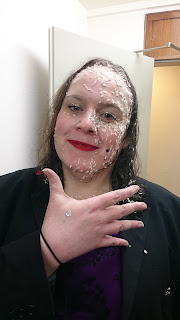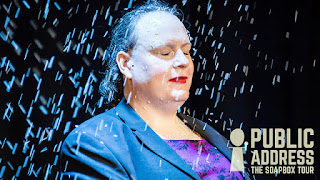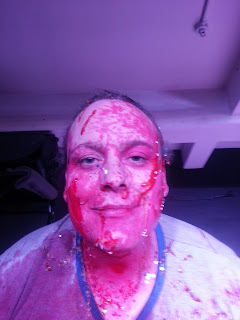(STOP! This post is a sequel to this one, describing the genesis of my Public Address piece, 'Shotgun Wedding', and this one, describing its evolution in response to some constraints we ran up against - so if you haven't read the previous two posts, you may wish to do so now. If you have, then read on...)
We ended the last post just prior to the first performance of the Public Address tour at
Alphabetti Theatre in Newcastle, and with me somewhat concerned that without the fake blood we'd used in our test run, the piece might not have as much of an effect on the audience. It's fair to say that Alphabetti had concerns themselves - the clean-up after the test run we'd staged there had been a nightmare, with ketchup sticking to surfaces and attracting pests. This meant that the tour, for me, started with something of a first as, to assuage the venue's concerns, I spent a good couple of hours prior to our tech rehearsal duct-taping dust-sheeting to the stage. Frankly, I felt like Dexter:

By the end of all this my knees had taken a pounding from crawling around the hard stage, we still needed to rehearse and - for logistical reasons, a stage covered in rice being tricky to clean up - my piece wasn't going to take place until the end of the show. So there was a lot of nervous pacing around backstage for me while the other performers did their thing. Everyone at the first gig was uniformly brilliant, as people were throughout the tour. This, of course, only raised the stakes for me because it meant that if my weird live art/performance poetry mash-up bit went down like a lead balloon it was only going to stand out more - and I was going to have to do it four more times, as well...
The first order of business, though, was to get reasons from the venue audience. I'd been asking people in the run-up to the tour to give me things their partners had done that proved their relationships either were or weren't love, and had got a lot of these online, but I wanted to collect reasons from the audience at the venues too. I was a little nervous doing this on the first night - it seemed very like flyering, which I'd found a not exactly pleasant experience in Edinburgh over the summer - and we were up against it for time, but I managed to get people to fill in a couple of cards. Then, it was time to start the show. All the performers took the stage for a brief introduction, and then we each did our solo sections, so all I could do was wait.
Any fears I had that the Newcastle audience might not go for it with the rice-throwing and firing of water pistols were dispelled when I began asking people questions during my introduction to the piece. A forest of hands shot up for both my questions - 'Who, here, has ever been in love?' and 'Who here has been in a relationship which has gone terribly, terribly wrong?' - and one member of the audience, fellow poet
Rowan McCabe, was so enthusiastic in thrusting his hand up for the second question that I asked him it, even though I'd also taken his answer to the first. Clearly excited, the audience members we selected to provide physical feedback in response to the reasons we'd collected got
heavily into doing exactly that: Newcastle was one of only two venues on the tour where I didn't know if I could
physically take the pressure during the performance. You see, for all that I'd wanted to ramp up the violence of the water pistols, the fact is that water is water, but having dry rice thrown at you
fucking hurts.
 |
Above photos from the Plymouth Public Address performance, courtesy of Greenbeanz Photography
|
The rice got in my hair. It got in my mouth, and I had to pause to extract grains of it before continuing (I found that if I did this in as deadpan a way as possible, it got a huge laugh from the audience). It got in my eyes: being hit in the eyes with rice is painful enough, but I only later found that the glitter confetti we'd mixed in with it could have been a more dangerous proposition -
glitterbomb recipients like Mike Huckabee and Newt Gingrich have argued that the practice is dangerous because glitter can, theoretically,
scratch your corneas - so there was an element of real physical risk involved in this, I guess. Or maybe Gingrich and Huckabee are just massive wimps.
(It wasn't lost on me that, during the London and Southampton legs of our tour, another famed glitterbomb recipient, Germaine Greer, was complaining about people protesting her being invited to speak at universities in the UK. Three of the theatres we took Public Address to - The House at Plymouth University, the Bloomsbury Theatre in London (affiliated with UCL) and the Nuffield at Southampton Uni - were university theatres. So while transphobic glitter-victim Germaine was complaining about not getting to speak at universities I, a trans person, was visiting universities and actually
encouraging people to glitterbomb me. Which is kind of ironic, I think...)
I do know, because they told me, that some audience members were mindful of the possible damage they could do to my eyes, and tried to restrict themselves to throwing rice at my torso instead. This wasn't really what I was after, and, upon being told as much after the Southampton gig, I resolved that at the final show in Birmingham I would make an especial effort to give the audience explicit permission to go as wild as they liked with the rice (or, as I put it on the night 'I want you to really
fuck me up'). The Brum crowd more than delivered:
 |
| Fucked up gooood after the Birmingham performance |
In general, people went for it in pretty much every venue where I performed the piece. Newcastle and Birmingham were easily the most enthusiastic audiences when it came to getting physical: I've written above about how in Newcastle I genuinely wasn't sure I could continue, and there was a similar point during the Birmingham gig when I found myself looking up at Hannah Silva in the tech booth in desperation, thinking something had gone wrong and the piece had to be overrunning - to allow me to transition from the randomly chosen reasons to the poem I'd written for the piece, Hannah had put together a soundscape which would run underneath the action, which contained an audible cue for me to shift into the poem at roughly the seven-minute mark. This soundscape was roughly the same as the opening soundscape for the show, and during the Brum performance, as I was pelted with rice, I became convinced that the two soundscapes had gotten mixed up and we'd gone on way longer than seven minutes. And then the gong came in, and I realised I only
thought it had been going on longer.
It was also interesting seeing
what caused people to hurl rice, and what got them firing their water pistols at me. I'd wanted many of the reasons to be ambiguous, and they were. Of particular note was that
a lot of the acts of violence described ('because you choke me', 'because you slap my face', 'because you pull my hair' etc) were greeted with very enthusiastic rice-throwing in Newcastle, and got me drenched when they came out in Birmingham. I leave it to you to draw your own conclusions about the relative kinkiness of both cities.
 |
| Plymouth performance photo courtesy of Greenbeanz Photography |
If Newcastle and Birmingham were the most enthusiastic cities when it came to getting physical with the rice and water pistols, that doesn't mean that London, Plymouth or Southampton held back
that much. And there were other ways in which audiences got involved beyond just throwing and firing stuff at me. Southampton, for example, was where I got the most reasons given to me by the audience at the venue. Partly this was because we had an interval between the open mic that formed the start of the Southampton gig, a special edition of their local poetry night,
451, and our performances, which gave me an obvious point to solicit contributions, and also because, by this point, I'd honed my patter enough to explain what I was up to.
 |
| London performance photo by Suzi Corker for Apples and Snakes |
The conversations continued
after the performances as well. Although I was covered in rice, not being covered in fake blood meant it was relatively easy to shake off the stuff, which meant that rather than having to stop for a post-gig shower, I could chat with the audience at the bar (even if I did keep picking bits of rice and confetti out of my hair while chatting). The Newcastle, Birmingham and Southampton audiences were keenest to hang around and talk - perhaps because in each of those venues we were plugging into something usually used by the local spoken word scene, while Plymouth and London, especially, were more theatre crowds, and so more inclined to head off after the show. Lots of discussion centred on the reasons, and people's responses - two people in two different venues let me know that reasons which the audience had received favourably were actually ones they'd intended to stand for the
opposite of love, for example - but a number of other topics came up. An audience member in Newcastle saw my performance as akin to sacred clowning - allowing myself to look ridiculous to facilitate the audience confronting some deep stuff - although another audience member likened the act to 'a kind of poetry
bukkake' (link very much NSFW). Interestingly enough, a chat with an audience member after the Southampton gig suggested this might be closer to the truth than I'd thought - the custom of throwing rice at weddings is a survival of a Roman custom in which
wheat was thrown, to symbolise 'fertility', so in a sense the rice stands for sperm.
Not something I'd been conscious of in developing the piece, but if the sheath fits...
 |
| London performance photo by Suzi Corker for Apples and Snakes |
Speaking of wedding customs, you may notice that there's a change in my outfit in the above photos. My initial outfit for the Newcastle and Plymouth shows was a black top and leggings - a little goth, but I thought black would really make a nice contrast with the rice.
 |
| Plymouth performance photo by Greenbeanz Photography |
Before the London and Southampton shows, however, Hannah suggested that we should dress up a bit, to give the audience more of a feeling that they were at a show. I don't have a lot of really
smart stuff in my wardrobe to be quite honest, so I cobbled something together using jeans, a purple top, and an old men's suit jacket I still have in my wardrobe.
It only occurred to me
after the London gig, the first I did in this outfit, that said old men's suit jacket was in fact the jacket from the suit I got married in, back in 2006. Which seemed curiously apt, for a piece called 'Shotgun Wedding', which explored themes of love and its opposite, of what is and isn't love, and how you know. I'm divorced now - my ex and I are still good friends, in fact I visited her in Birmingham after our gig there - and the elements of the poem I end the piece with are drawn from both my marriage and my other longest romantic relationship. When I wrote on this blog that there are ways in which this piece is
a tribute to all our lovers, I included my own.
But it wasn't just about me, of course. In many ways, that's been the most satisfying thing about this piece: all those of you who contributed reasons, whether online or in person at venues, those of you who got up from the front row and threw rice or fired water, all those who sat behind them and shouted your own choices (or in one case very visibly mimed a gun): this has been your piece as much as it's been mine. I set out, in this piece, to create something that stepped away from the poet-as-prophetic-orator, dispensing
strong truth to the audience dynamic, and I think I've achieved that. This hasn't just been a performance, this has been a conversation, and it's been one I'm honoured to have had with you. Thank you, all of you, for your time.






















